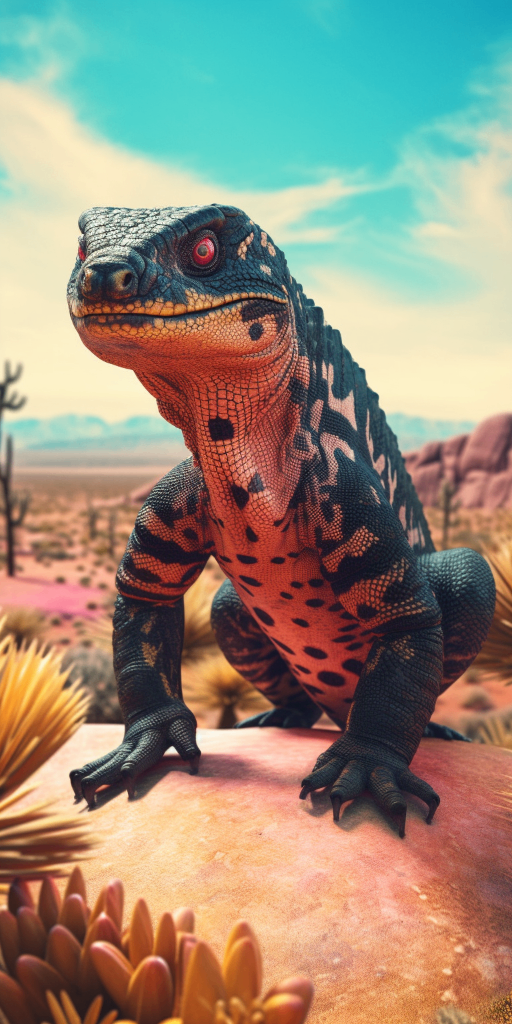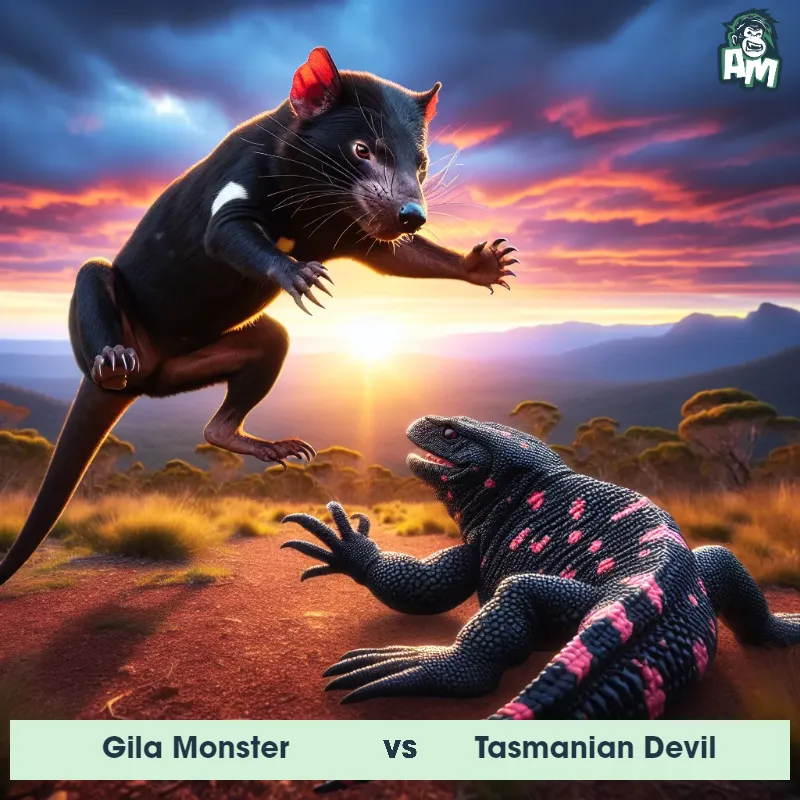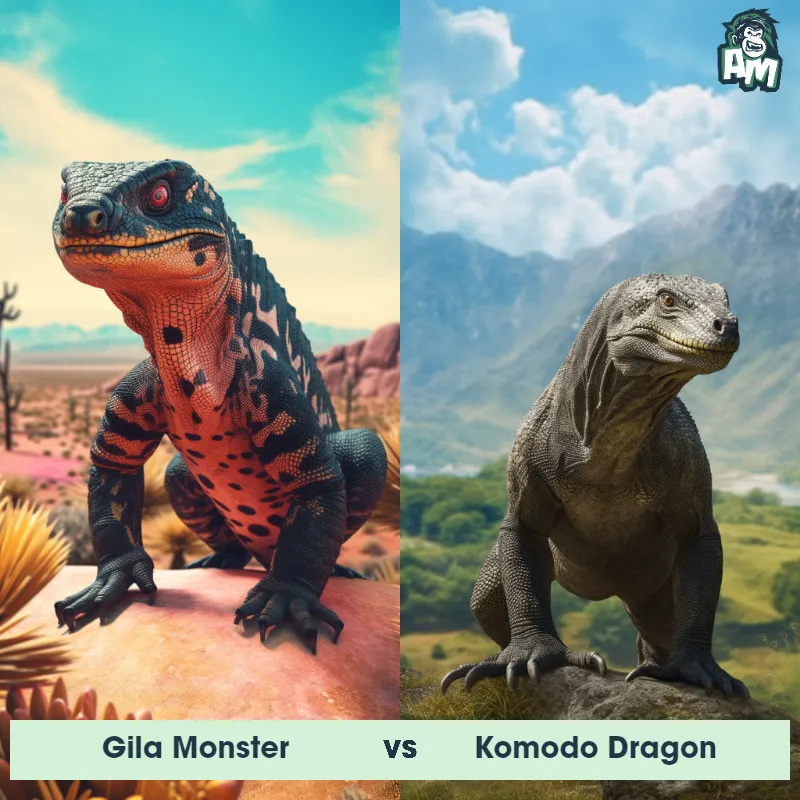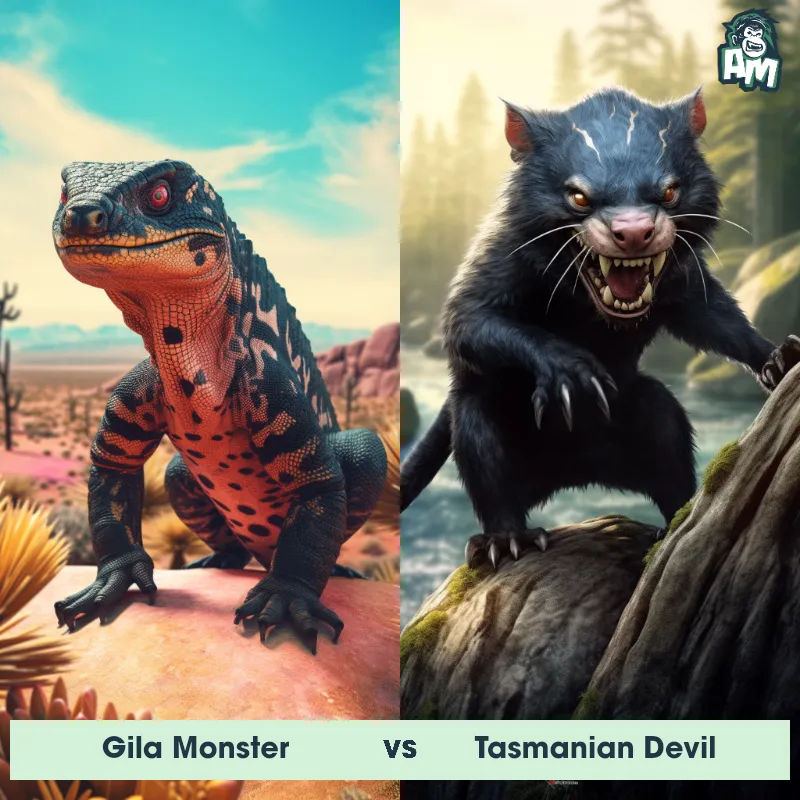The Gila Monster
The Gila Monster, also known by its scientific name Heloderma suspectum, is a venomous lizard native to the southwestern United States and northwestern Mexico. This stocky reptile is easily recognized by its distinct orange and black banded skin, which serves as a warning to potential predators. Gila Monsters have a heavy, powerful build, with a wide head, short limbs, and a thick tail. They can grow up to 22 inches long and weigh around 5 pounds. Known for their slow movement, Gila Monsters are mainly active during the night and early morning, spending much of their time hidden in rocky crevices or underground burrows. They possess a strong bite and a unique venomous bite system, making them one of only two venomous lizard species in the world.

| Gila Monster | |
|---|---|
| Size | 20-24 inches (50-60 cm) |
| Weight | 1-2 pounds (0.5-1 kg) |
| Speed | Speed: 2-3 mph (3.2-4.8 km/hr) |
| Key Strength | Powerful bite and venomous bite |
| Biggest Weakness | Slow movement and short legs |
| Scientific Name | Heloderma suspectum |
| Family | Helodermatidae |
| Habitat | Desert and scrubland |
| Geography | Southwestern United States and northwestern Mexico |
| Diet | Small mammals, birds, eggs, and reptiles |
| Lifespan | 20 years - 30 years |

The Gila Monster
The Gila Monster, also known by its scientific name Heloderma suspectum, is a venomous lizard native to the southwestern United States and northwestern Mexico. This stocky reptile is easily recognized by its distinct orange and black banded skin, which serves as a warning to potential predators. Gila Monsters have a heavy, powerful build, with a wide head, short limbs, and a thick tail. They can grow up to 22 inches long and weigh around 5 pounds. Known for their slow movement, Gila Monsters are mainly active during the night and early morning, spending much of their time hidden in rocky crevices or underground burrows. They possess a strong bite and a unique venomous bite system, making them one of only two venomous lizard species in the world.
Fun Fact: The Gila Monster possesses a venomous bite that is strong enough to immobilize its prey and deter predators, but it is not usually lethal to humans. However, getting bitten by a Gila Monster can be an extremely painful experience due to its venomous saliva, which contains neurotoxins and enzymes that interfere with blood clotting.
| Gila Monster | |
|---|---|
| Size | 20-24 inches (50-60 cm) |
| Weight | 1-2 pounds (0.5-1 kg) |
| Speed | Speed: 2-3 mph (3.2-4.8 km/hr) |
| Key Strength | Powerful bite and venomous bite |
| Biggest Weakness | Slow movement and short legs |
| Scientific Name | Heloderma suspectum |
| Family | Helodermatidae |
| Habitat | Desert and scrubland |
| Geography | Southwestern United States and northwestern Mexico |
| Diet | Small mammals, birds, eggs, and reptiles |
| Lifespan | 20 years - 30 years |
Match Highlights
Gila Monster Matchups
We use AI to simulate matchups between the Gila Monster and other animals. Our simulation considers size, strength, and natural predatory behaviors to determine the most likely outcome.

Can't find the Matchup you want?
Create Your Own MatchupGila Monster: Diet, Predators, Aggression, and Defensive Behaviors
What do Gila Monsters eat?
Gila Monsters are carnivorous reptiles that primarily feed on small mammals, birds, eggs, and carrion. Their diet also includes insects, amphibians, and other reptiles. Gila Monsters are known for their relatively slow metabolism, allowing them to survive on infrequent meals.
Do Gila Monsters have any predators?
Although adult Gila Monsters have few natural predators, they may fall prey to coyotes, birds of prey, and larger reptiles. Juvenile Gila Monsters are more vulnerable and can be targeted by a wider range of predators, including snakes and carnivorous mammals.
Are Gila Monsters aggressive?
Gila Monsters are typically shy and reclusive animals that prefer to avoid confrontation. However, they are known for their bold defense tactics when threatened, including hissing, tail-swishing, and delivering a painful bite. These behaviors are often interpreted as aggression, but Gila Monsters are more accurately described as defensive rather than aggressive.
Do Gila Monsters fight?
Gila Monsters are solitary animals that do not engage in organized fights with conspecifics. However, males may compete for access to females during the breeding season through ritualized displays and posturing. These interactions rarely escalate into physical combat.
How do Gila Monsters defend themselves?
Gila Monsters rely on various defensive strategies to protect themselves from predators. Their most notable defense mechanism is their venomous bite, which can cause intense pain and swelling in humans. In addition to their venom, Gila Monsters use their intimidating size, coloration, and behavior to deter potential threats.
What is the biggest weakness of Gila Monsters in a fight?
Despite their formidable reputation as venomous predators, Gila Monsters are relatively slow-moving and possess limited agility. In a physical confrontation, their sluggish nature and lack of speed make them vulnerable to more agile predators or larger threats. Additionally, their reliance on venom as a primary defense mechanism requires them to get close to their target, putting them at risk of injury.
Fun Fact: Unlike most lizards, the Gila Monster is a unique species that has a reputation for being a slow mover. It has a slow metabolism and can go for months without eating due to its ability to store fat in its tail and body. This allows the Gila Monster to survive in harsh desert environments where food may be scarce.
Fun Fact: The Gila Monster has a peculiar behavior known as "helicopter tail," which involves rapidly waving and rotating its tail in the air. While the exact purpose of this behavior is still unknown, scientists speculate that it may serve as a form of communication between individuals or as a distraction technique to confuse predators. The distinctive movement of its tail adds to the unique characteristics and behaviors of this fascinating lizard species.













